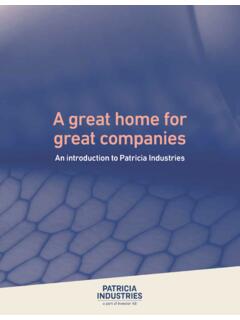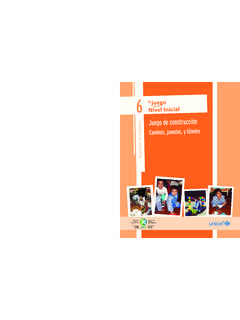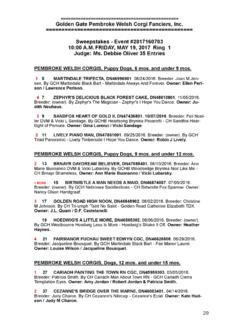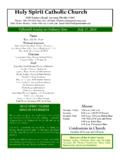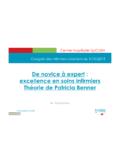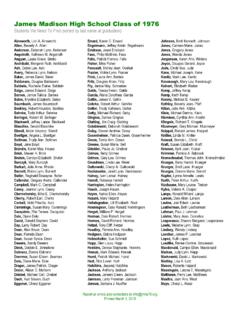Transcription of P.R.I.M.E. and its many Uses - A new vocabulary for ...
1 And its many uses J. Lopreiato MD, MPH Uniformed Services University and its many Uses - A new vocabulary for evaluation in the 21st century Joseph O. Lopreiato, MD, MPH Professor of Pediatrics adapted from L. Pangaro MD, USUHS Background: Competencies are ACGME defined behaviors expected of finishing residents in the USA. Competencies are not scary, just a common way of communicating skill acquisition. Each competency is measured along a continuum called milestones. However, these terms are complex and confusing as descriptors of performance in the hands of all teachers. Consider: A new vocabulary aimed at better documenting the competencies that all faculty can recognize, observe and write about.
2 A new system should have: Simple phrases that all faculty and learners can remember. Be easy for faculty to observe and write about performance. Be easy for learners to know what the endpoints are during training. Use a common vocabulary to measure progress across rotations and for learners to gauge progress. Have high reliability and validity. and its many uses J. Lopreiato MD, MPH Uniformed Services University 2 Examples: What s wrong with our current descriptive system of performance documentation? See for Here are some typical examples abstracted from our residency program evaluation forms: "Needs to work on follow-through of plans, communicating with staff.
3 Will refer to Program Director." "Very pleasant. Fun to work with. Seemed to enjoy Ped ED setting. Overall, performed as expected." "Solid FOK, gets the job done." "Great job. No problems w/ students, staff, patients. Supervised well. Knew his patients. Organized." "Exceeded all expectations. Very bright and organized." "Although a likable person, at times he appeared to be confused during the rotation." "Work on FOK. Did overall." "Pleasant. Interested in learning. Performed as expected" These nonspecific written evaluations lack reliability (based on lack of structure) and are mostly focused on personality rather than performance domains.
4 They reflect the type of comments referenced in the article by Patricia Lye in Ambulatory Pediatrics 2001 1:128-131. and its many uses J. Lopreiato MD, MPH Uniformed Services University 3A Solution: Devise a structure of performance domains common to all learners and consistent with the ACGME competencies. One such system had been devised and field tested by Dr. Louis Pangaro, Professor of Medicine at the Uniformed Services University School of Medicine. The mnemonic was developed by him, to which we have added the additional domain of Professionalism. Therefore the mnemonic become . Here are the domains of the mnemonic PROFESSIONALISM Did the learner demonstrate Professionalism?
5 Reliability, Responsibility, Teamwork Respect for patient s values Punctuality Respect for staff and peers Appropriate attire for clinical care Demeanor and Comportment REPORTER Is the learner a reliable and honest reporter? Interviewing skills Physical Examination skills Written Documentation Oral case presentations INTERPRETER When given data, can the learner interpret them? Problem Prioritization Differential Diagnosis formation Interpreting clinical data (Hx,PE,Labs) and its many uses J. Lopreiato MD, MPH Uniformed Services University 4 MANAGER Can the learner manage patients (or manage a team)?
6 Management of individual patients Management of a medical team Formulate Diagnostic Plans Formulate Therapeutic Plans Demonstrate Risk/Benefit Decision making Be proficient at Basic Procedures (IVs, etc.) Be proficient at Advanced Procedures Incorporates Patient Values into Medical Plan EDUCATOR Does the learner demonstrate educator qualities? Self-directed Learning Skills Good response to Feedback Critical Reading Skills Teaching Skills with peers and subordinates What is needed to reach the next step in their professional development as a physician?
7 And its many uses J. Lopreiato MD, MPH Uniformed Services University 5 Prime is Developmental and it can be used to measure progress in a Aspect of professional growth MS - III MS - IV Intern PGY 2+ & beyond REPORTER M Interviewing M Physical Examination M Written Documentation P M Oral case presentations P M INTERPRETER P M Problem Prioritization M Differential Diagnosis P M Interpreting Data (Hx,PE,Labs) I P M MANAGER I P M Management of individual patients I P M Management of a medical team I P & M Diagnostic Plans I P M Therapeutic Plans I P P M Benefit/Risk Decision making I P P M Basic Procedures (IVs, etc.)
8 I P M Advanced Procedures I P M Incorporates Patient Values in Plan I P M and its many uses J. Lopreiato MD, MPH Uniformed Services University 6 EDUCATOR Self-directed Learning I P M Response to Feedback I P P M Critical Reading Skills I P P M Teaching Skills I P P M PROFESSIONALISM Reliability, Responsibility, Teamwork M Respect for patient s values M Punctuality M Respect for staff and peers M Appropriate attire for clinical care M Demeanor and Comportment M *I = introduced in the curriculum P = practiced, repetition M = mastered.
9 Sufficient proficiency for the next level of independence The Matrix illustrates the concept of progressive mastery. In problem learners, PRIME can be used to identify weak areas and the next steps to be A problem learner may have difficult being a concise and accurate reporter. They will need remediation before the learner can progress to being a good learner cannot be a good interpreter until they have mastered being a good reporter. The same holds true for learners who are having problems interpreting data, they cannot progress to manager until they have a fund of knowledge and the ability to interpret data correctly.
10 And its many uses J. Lopreiato MD, MPH Uniformed Services University 7 Our Experience: In our residency program over the last decade, we have taught our faculty how to remember the PRIME format when observing and writing about trainees. Here are examples of write-ups using the format. These are transcribed from actual written comments during clinical rotations. The domains of PRIME are underlined for your convenience. 1. She is a reliable reporter, although initially she seemed to want to embrace all the problems found in the review of systems in one visit - this improved greatly as she seems to be able to focus & prioritize her histories much more effectively for the clinic setting.

